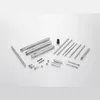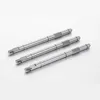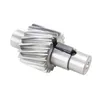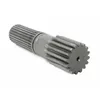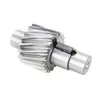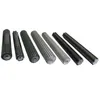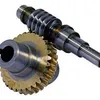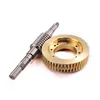A Gear Shaft is a mechanical component designed to transmit torque and rotation between machine parts, often featuring gears integrated onto a shaft. It plays a critical role in various industries, including automotive, manufacturing, and aerospace, by ensuring efficient power transfer and motion control.
Our gear shafts are engineered with precision to meet high-performance standards. Below are the detailed specifications in a list format for clarity:
For a comprehensive overview, refer to the table below summarizing key parameters:
| Parameter | Specification | Units |
|---|---|---|
| Material Grade | Alloy Steel (e.g., AISI 4140), Stainless Steel (e.g., 304/316) | - |
| Hardness (Surface) | 58-62 HRC | HRC |
| Diameter Tolerance | ±0.05 mm | mm |
| Length Tolerance | ±0.1 mm | mm |
| Maximum Torque Capacity | Up to 1000 Nm | Newton-meters |
| Weight (per 100 mm length) | 0.5 - 2.5 kg (varies with diameter) | Kilograms |
| Operational Speed | Up to 5000 RPM | RPM |
| Lubrication Requirement | Grease or oil-based lubricants recommended | - |
Gear shafts are utilized in a wide range of applications due to their versatility and reliability. Common uses include:
What factors should I consider when selecting a gear shaft?
Consider the application load, speed, environmental conditions (e.g., temperature, corrosion), material compatibility, and required precision. For high-torque applications, alloy steel with heat treatment is recommended, while stainless steel suits corrosive environments.
How do I maintain a gear shaft to ensure longevity?
Regular lubrication is essential to reduce friction and wear. Inspect for signs of wear, misalignment, or damage periodically. Use appropriate lubricants based on operating conditions, and ensure proper installation to avoid overloading.
Can gear shafts be customized for specific applications?
Yes, we offer customization options including material selection, diameter and length adjustments, gear type variations, and special coatings. Provide detailed requirements for tailored solutions.
What is the typical lead time for ordering a custom gear shaft?
Lead times vary based on complexity and quantity. Standard orders ship within 2-3 weeks, while custom designs may take 4-6 weeks. Rush services are available for urgent needs.
How does temperature affect gear shaft performance?
Extreme temperatures can cause expansion or contraction, affecting tolerances and lubrication. Our shafts are designed with materials and treatments to withstand ranges from -40°C to 150°C, ensuring stable operation.
Are there any industry standards that your gear shafts comply with?
Our products meet ISO 9001:2015 for quality management and relevant ASTM standards (e.g., ASTM A29 for steel). Certifications are provided upon request to ensure compliance and reliability.
What is the difference between a spur gear shaft and a helical gear shaft?
Spur gear shafts have straight teeth and are efficient for low-speed applications, while helical gear shafts have angled teeth, offering smoother and quieter operation at higher speeds but may require thrust bearings due to axial loads.
How do I determine the correct gear shaft size for my machinery?
Calculate the required torque, RPM, and load based on your application. Consult engineering specifications or use our online sizing tool; our support team can assist with recommendations to ensure optimal fit and performance.
